The bond market took the surprise lack of rate cut by the RBI in its policy review last week, as a sign of the government showing higher than budgeted fiscal deficit for this fiscal year. Yields shot up across the government bond, OIS, money market and corporate bond yield curves on expectations of extra market borrowings by the government.
RBI said it is waiting for the budget for fiscal 2020-21 in February before it takes its next step on rates, implying that the budget could be a borrow and spend budget that could lead to higher inflation down the line. Hence there could be doubts on more rate cuts that will keep yields at higher levels.
The government has been taking overdraft from the RBI to meet its expenditure. The revenue shortfall for this fiscal year could be well over Rs 2 trillion on the back of corporate tax rate cuts and a sharply slowing economy Government accessing RBI WMA and spending is leading to huge excess liquidity in the system. In order to repay WMA, government issues CMBs (Cash Management Bills) that are short term in nature but if revenue shortfall is long lasting, the government has to borrow to repay the WMA.
Bond market is uncertain on the timing of the borrowing and is preferring to play safe rather than being caught out by a sudden borrowing announcement, which could hut if bond yields are down. The status quo in the policy gave the market an opportunity to take up yields. Bond yields will stay at higher levels until the government comes out with a clear communication on its finances.
The benchmark 10-year bond, the 6.45% 2029 bond, yields jumped by 20 bps to 6.67% on a weekly basis. The benchmark 5-year bond, the 6.18% 2024 bond, yield soared by 18 bps to 6.37% and the 6.68% 2031 bond yield declined by 15 bps to 7.06%.
One-year OIS yield jumped by 29 bps to 5.30% while the five-year OIS yield increased by 35 bps to 5.44% on a weekly basis.
System liquidity as measured by bids for Repo, Reverse Repo, Term Repo and Term Reverse Repo in the LAF (Liquidity Adjustment Facility) auctions of the RBI and drawdown from Standing Facility (MSF or Marginal Standing Facility) was in surplus of Rs 3089.69 billion as of 06th December 2019. Liquidity was in a surplus of Rs 2424.42 billion as of 29th November 2019.

